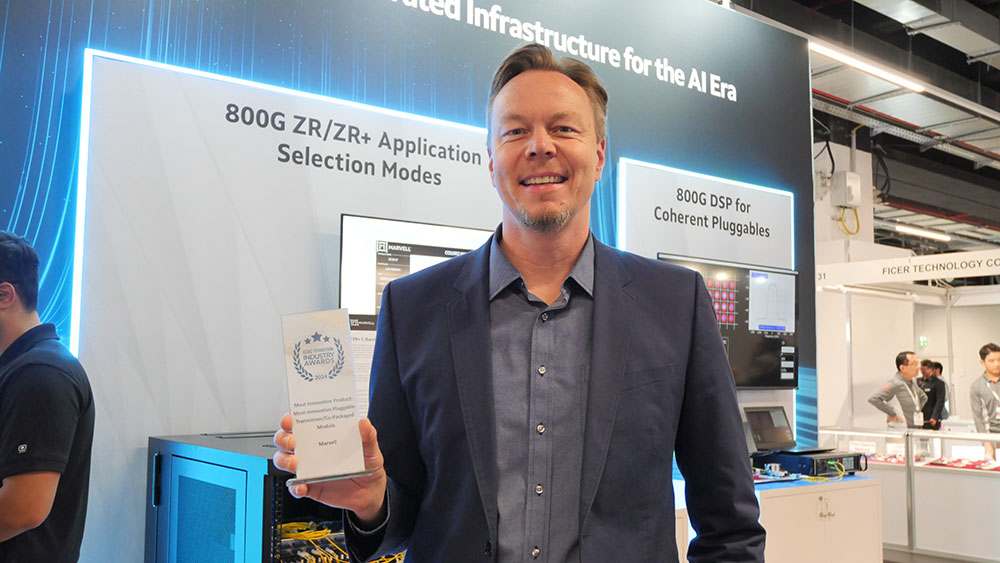

With AI computing and cloud data centers requiring unprecedented levels of performance and power, Marvell is leading the way with transformative optical interconnect solutions for accelerated infrastructure to meet the rising demand for network bandwidth.
At the ECOC 2024 Exhibition Industry Awards event, Marvell received the Most Innovative Pluggable Transceiver/Co-Packaged Module Award for the Marvell® COLORZ® 800 family. Launched in 2020 for ECOC’s 25th anniversary, the ECOC Exhibition Industry Awards spotlight innovation in optical communications, transport, and photonic technologies. This recognition highlights the company’s innovations in ZR/ZR+ technology for accelerated infrastructure and demonstrates its critical role in driving cloud and AI workloads.

Coherent optical digital signal processors (DSPs) are the long-haul truckers of the communications world. The chips are essential ingredients in the 600+ subsea Internet cables that crisscross the oceans (see map here) and the extended geographic links weaving together telecommunications networks and clouds.
One of the most critical trends for long-distancer communications has been the shift from large, rack-scale transport equipment boxes running on embedded DSPs often from the same vendor to pluggable modules based on standardized form factors running DSPs from silicon suppliers tuned to the power limits of modules.
With the advent of 800G ZR/ZR+ modules, the market arrives at another turning point. Here’s what you need to know.
It’s the Magic of Modularity
PCs, smartphones, solar panels and other technologies that experienced rapid adoption had one thing in common: general agreement on the key ingredients. By building products around select components, accepted standards and modular form factors, an ecosystem of suppliers sprouted. And for customers that meant fewer shortages, lower prices and accelerated innovation.
The same holds true of pluggable coherent modules. 100 Gbps coherent modules based on the ZR specification debuted in 2017. The modules could deliver data approximately 80 kilometers and consumed approximately 4.5 watts per 100G of data delivered. Microsoft became an early adopter and used the modules to build a mesh of metro data centers1.

Flash forward to 2020. Power per 100G dropped to 4W and distance exploded: 120k connections became possible with modules based on the ZR standard and 400k with the ZR+ standard. (An organization called OIF maintains the ZR standard. ZR+ is controlled by OpenROADM. Module makers often make both varieties. The main difference between the two is the amplifier: the DSPs, number of channels and form factors are the same.) ®
The market responded. 400ZR/ZR+ became adopted more rapidly than any other technology in optical history, according to Cignal AI principal analyst Scott Wilkinson.
“It opened the floodgates to what you could do with coherent technology if you put it in the right form factor,” he said during a recent webinar.
By Suhas Nayak, Senior Director of Solutions Marketing, Marvell

In the world of artificial intelligence (AI), where compute performance often steals the spotlight, there's an unsung hero working tirelessly behind the scenes. It's something that connects the dots and propels AI platforms to new frontiers. Welcome to the realm of optical connectivity, where data transfer becomes lightning-fast and AI's true potential is unleashed. But wait, before you dismiss the idea of optical connectivity as just another technical detail, let's pause and reflect. Think about it: every breakthrough in AI, every mind-bending innovation, is built on the shoulders of data—massive amounts of it. And to keep up with the insatiable appetite of AI workloads, we need more than just raw compute power. We need a seamless, high-speed highway that allows data to flow freely, powering AI platforms to conquer new challenges.
In this post, I’ll explain the importance of optical connectivity, particularly the role of DSP-based optical connectivity, in driving scalable AI platforms in the cloud. So, buckle up, get ready to embark on a journey where we unlock the true power of AI together.
Copyright © 2025 Marvell, All rights reserved.
